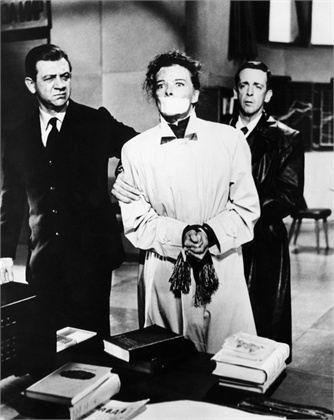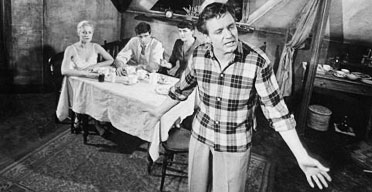From the previous post that brought up Harry Saltzman, one of the originators of developing the social realism genre of film. Of course, Saltzman did not operate in a vacuum, but he had an intuitive sense that connected the north American variant with an older European tradition. That whole Depression era aesthetic that included Sacco and Vanzetti, the millions of poor and near starving Americans, Ben Shahn style art, John Dos Passos, John Steinbeck, Robert Capa, Woody Guthrie, all culminating in a war. It was termed the “kitchen sink” style that in itself was a corrupted form of romanticism that ultimately transformed itself into the pop culture we know today.They were stating the obvious: life itself in all its social and psychological mess was not a harmoniously shaped form. If Davinci’s golden mean and divine form existed it was buried under a refuse dump.

---The Iron Petticoat 1956 Sid James (left), Katharine Hepburn (center), 1956---Read More:http://www.vogue.it/en/encyclo/cinema/t/trench
There was a lot of misogyny given that the leitmotif was the explosive hormones of the angry young man.Your James Dean and Marlon Brando types.The alienation tht found expression in Jack Kerouac, Ginsberg and the west coast beats. More profoundly, you can look at European import directors like Ernst Lubitsch and Billy Wilder and working the oeuvre; something parallel and antagonistic to the cant of Wyndham Lewis and T.S. Eliot. Saltzman can be placed within this context as a significant figure in his own way, and one clearly with an antipathy to those dallying and flirting with fascist ideas.

Read More:http://www.guardian.co.uk/stage/2006/mar/31/theatre2 ---The legend is that Look Back in Anger changed British theatre for ever, replacing stage-sets of Belgravia mansions with a drab Midlands flat, and smart upper-class remarks with the angry anti-establishment rants of its hero, Jimmy Porter. It's a measure of how unexpected the setting was that, at the first performances, the sight of Alison Porter's ironing-board on stage is said to have drawn from the audience the sort of gasp of surprise otherwise achieved only by the most innovative cinematic special effects. In an era of feel-good theatre (although Rattigan's plays were darker or deeper than their first productions allowed them to be), Look Back in Anger deliberately provoked bad feelings about Britain, the war-time generation and conventional drama.---
T. S. Eliot was fabricating a mythical Waste Land after WWI, basically intellectualized fantasy, ultimately a kind of decadence disguised as preachy pulpit morals. Ritualistic. punitive, sermons admonishing them for how deep they have sunk into the mud, how futile their lives are, and some vague promise to raise them up. The so-called kitchen sink then skirted populism by being underpinned, narrative tension of real mortality and suffering without the T.S. Eliot forced and faked stylistic numbness , poses and gestures. Its doubtful anyone could have foreseen the extent to which this sort “dissent”, and individualism would become a defining aspect of postmodern culture very ingeniously embedded within modern advertising as commodity in the dissent industry.








 COMMENTS
COMMENTS



